
by Mary Caperton Morton Friday, September 4, 2015
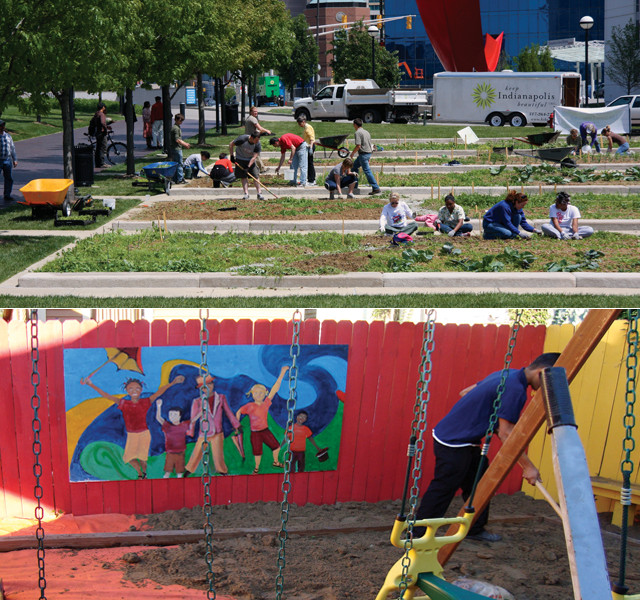
Community gardens (such as the one above in Indianapolis) and playgrounds are common places where children can come into contact with lead-contaminated soils in the urban environment. Remediation at the playground above was funded by the Greater New Orleans Foundation and U.S. Department of Housing and Urban Development. Credit: top: Gabriel Filippelli/Indiana University; bottom: Howard Mielke/Tulane.
From a toxicological point of view, soaring lead levels in the home environment represented one of America’s lowest points — but efforts to improve the situation also led to one of our greatest success stories. After leaded gasoline and lead paints were identified as the culprits behind alarmingly high blood lead levels in children in the late 1970s, the federal government passed legislation banning the metal from these products, and many wide-reaching programs educated the public on how to reduce exposure to lead. By the 1990s, average blood lead levels in children exposed to lead in the home had dropped from 15 micrograms per deciliter of blood to just two.
Despite the dramatic drop, the dangers of lead exposure to public health have not yet passed entirely. Much of the lead we put into the environment before 1978, when lead-based paints were banned in the U.S., still remains. “With lead, there is no ‘away.’ Lead is an element, it doesn’t break down,” says Howard Mielke, a pharmacologist at Tulane University in New Orleans. “We might see it reduced by half in about 700 years, but we’re not talking within a human lifetime.”
In urban settings, where legacy lead levels are highest, some of the most common places where people come in contact with contaminated soils are parks and playgrounds, and more recently, community gardens. In the past few years, urban community gardens have flourished in many cities, giving inner-city residents a venue to grow their own fresh food and provide hands-on educational opportunities for kids. But with many urban gardens showing lead levels higher than the U.S. Environmental Protection Agency’s (EPA) recommended limit of 400 parts per million (ppm) — some plots test as high as 10,000 ppm — many urban plots are in need of remediation if they are going to produce safe food.
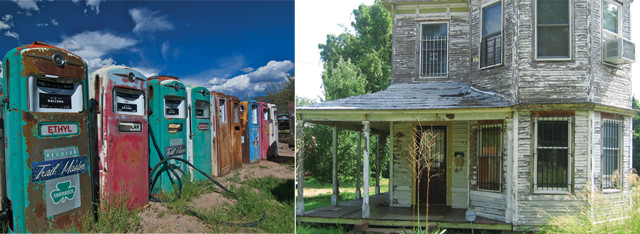
The major sources of lead added to urban environments have been old houses and leaded gasoline. Phase-outs of lead-based paint and the fuel additive tetraethyl lead began in the 1970s. Credit: left: Mary Caperton Morton; right: Kyle Rush, CC BY 2.0.
Until the late 1970s, lead was added to interior and exterior house paint to make it dry faster and to protect it against moisture damage. Once a house has been painted with lead paint — which the vast majority of houses built before 1978 were at some point — the lead is there to stay, even if repainted. Removing the old paint can often make the problem worse, as sanding and scraping sends fine particles into the air, which become stubborn constituents of household dust. “You can repaint over it and try to stabilize the surface, but you have to be vigilant to make sure the older leaded layers don’t break through,” says Kim Dietrich, an epidemiologist at the University of Cincinnati.
The major source of lead outside of homes came from cars, which released more than 7 million tons of lead into the atmosphere before a phase-out of the fuel additive tetraethyl lead started in 1973. Tetraethyl lead was added to gasoline to boost engine performance and increase fuel economy. Today, automobile gasoline is “unleaded,” but leaded gasoline persisted until after 1995, when an EPA regulation and a 1990 amendment to the Clean Air Act finally banned its sale in the U.S.
Using lead in household paints and in gasoline had disastrous consequences. By the late 1970s, children all over the U.S. were showing signs of lead poisoning. Symptoms of “lead poisoning run the gamut from stomach pain to learning disabilities and attention deficit disorders to death,” Dietrich says. And the long-term effects can be haunting. “We’ve followed children affected by lead through adulthood and seen deficits in IQ, and increased behavioral problems, juvenile delinquency and criminal behavior.”
The most common sources of childhood lead exposure and poisoning were interior dust in houses painted with leaded paint, water pipes soldered with lead and leaded food cans, which weren’t banned until 1995. “We know quite a bit about the exposure problem with lead,” Mielke says. “Under the age of two and a half, kids put everything in their mouths. That’s how they explore the world at that age. It’s part of being a young human.” Objects, toys and fingers collect minute particles of dust, which end up in kids’ mouths, and then in their digestive systems and blood.
Treatment for lead poisoning sometimes involves the use of chelating drugs, which “grab the lead molecules in the child’s body and help them to be excreted through the kidneys,” Dietrich says. However, the most important stage of treatment is usually to remove or remediate the source of lead, which is often logistically difficult and expensive.
“Exposure to lead has changed in that we’ve had major reductions in the amount of lead in the atmosphere by taking lead out of gasoline, but whatever lead was deposited in the decades before [its use was banned] is still there,” Dietrich says.
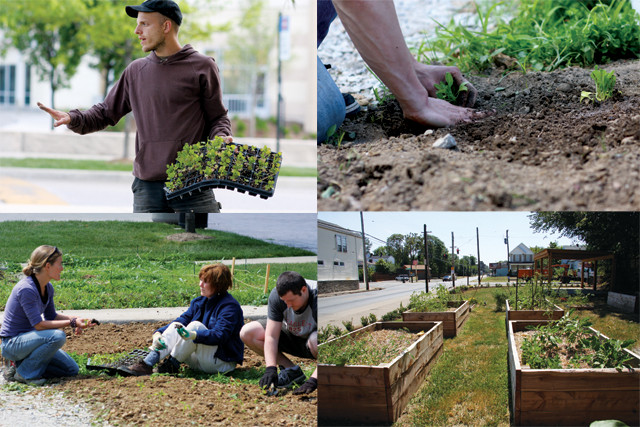
Community gardens are flourishing in many cities, giving inner-city residents a venue to grow their own fresh food and providing hands-on educational opportunities for kids and adults. But many urban soils have high lead levels. Credit: all: Center for Urban Health.
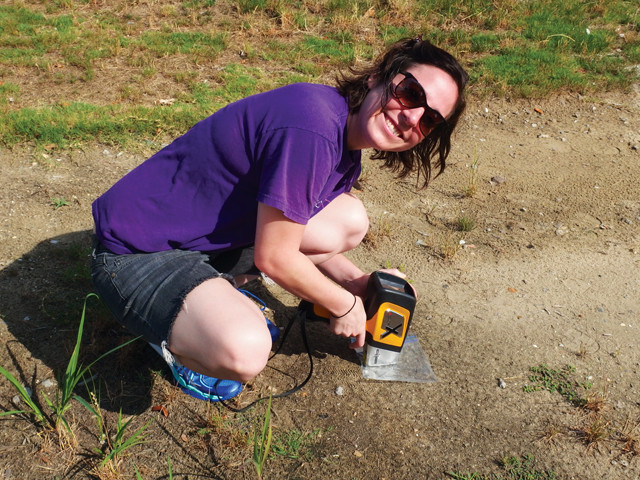
Tulane graduate student Elise Cahn measures lead levels in a garden site in New Orleans with an X-ray fluorescence meter. Credit: Howard Mielke/Tulane.
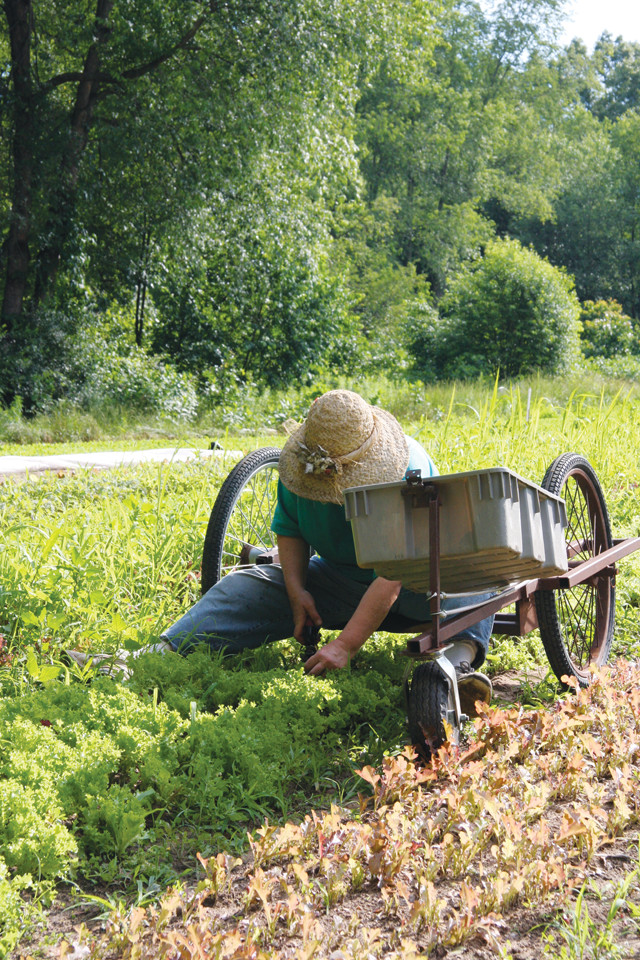
Often, fresh produce from urban gardens is not only more accessible than produce from grocery stores, but more affordable as well. Credit: Center for Urban Health.
The American obesity epidemic has cast a bright light on the scarcity of affordable, fresh food in many urban environments, particularly in low-income areas. In these places, residents often lack access to grocery stores that offer fresh produce, and, when fresh produce is available, it is often more expensive than packaged, processed foods. One solution to this problem has been to encourage the development of community gardens where people can grow their own food at low cost.
“In the past decade, there has been a huge growth in urban gardens, with both backyard and community plots popping up in cities all over the country,” says Gabriel Filippelli, a biogeochemist at Indiana University in Indianapolis. “Unfortunately, cities generally have very high levels of lead [in the soil] because they have so many lead-painted structures and had so much leaded gasoline burned in them for so long.”
Average soil lead values in U.S. cities hover around the EPA’s 400 ppm safety benchmark. But some plots, such as in downtown Indianapolis, test higher than 10,000 ppm. “That’s in contrast to the same soil types sampled away from cities that contain closer to 20 to 40 ppm,” Filippelli says.
“The problem of lead in urban gardens is just recently being recognized,” he says. “Here we have people trying to rejuvenate neighborhoods and create a sense of healthy community by producing good quality food, but there’s often this underlying problem that needs to be addressed.”
The first step for any community or backyard garden project should be to get the soil tested (see sidebar above), Filippelli says. In Indianapolis, Filippelli and his colleagues have been working on a citizen science project to create a map of lead concentrations around the city. People submit samples from their gardens and Filippelli’s lab tests for lead and other factors, including contaminants and nutrients, so they can recommend the types of fertilizer citizens might need to have a productive garden. “Then we use those data to create better lead maps of the city,” he says.
The team has found that the most contaminated areas of Indianapolis cluster around the city’s center. “It’s hard to find soils that are safe enough to grow [fruits and vegetables] within that bull’s-eye,” he says. But a number of techniques can reduce lead contamination.
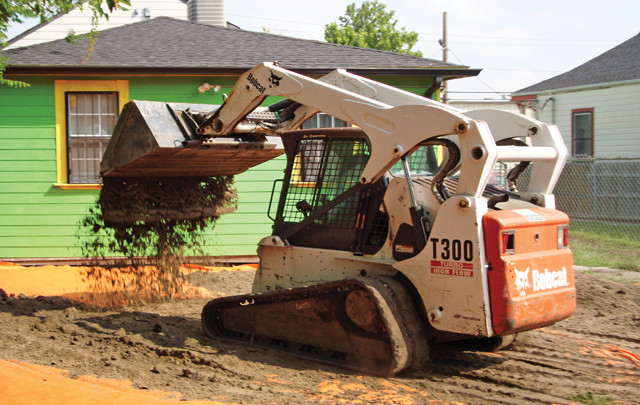
Capping contaminated soil is often the best solution to deal with lead-contaminated gardens. Credit: Howard Mielke/Tulane.
In 2010, a team from Cornell University led by soil scientist Murray McBride received a grant from the National Institutes of Health to assess the health of community garden soils in New York City. They collected more than 1,000 soil samples from gardens all over the city and tested for lead and other contaminants such as arsenic, zinc, cadmium and barium. They found a few outlier gardens with higher-than-recommended levels of arsenic and zinc, but lead was by far the most common contaminant.
“Most of the danger of gardening in leaded soils comes from tiny dirt particles that stick to plants. The dirt and lead can actually be washed off with a thorough scrubbing, though some types of produce are easier to wash than others,” Filippelli says. The most problematic plants with respect to lead contamination are root vegetables, which grow underground, because dirt can be difficult to wash off completely. Some root vegetables, such as carrots, have also been shown to take up lead into their edible roots, meaning the lead can’t simply be rinsed off with the soil.
“Leafy greens are also a problem because it’s difficult to wash lettuce thoroughly enough to remove all traces of lead. They tend to store a lot of dirt in leaf hairs,” Filippelli says. If a garden has more than 600 ppm of lead, “we recommend building raised beds and trucking in clean soil. Or not growing lettuce at all.” Fruiting crops like tomatoes, peppers, squash, eggplant and corn are generally the safest foods to grow in urban gardens because they don’t readily accumulate lead. Washing produce in water with vinegar or even very diluted dish soap can help as well.
Few studies have looked at the health effects of eating foods grown in soils with high lead concentrations, says Rufus Chaney, an agronomist with the U.S. Department of Agriculture in Beltsville, Md. The only food-related lead studies have attempted to quantify the absorption rates of lead in different circumstances, and the results suggest that the risks of lead poisoning from eating contaminated produce is low. “A few trials have given adult volunteers capsules with radioactive lead to take with meals and during fasting, and it’s clear that consuming lead with meals greatly reduces the absorption of lead,” he says. “When fasting, as much as 80 percent of soluble lead is absorbed. But if you eat it with a meal, only about 1 to 5 percent is absorbed and the rest is passed out through your digestive system.”
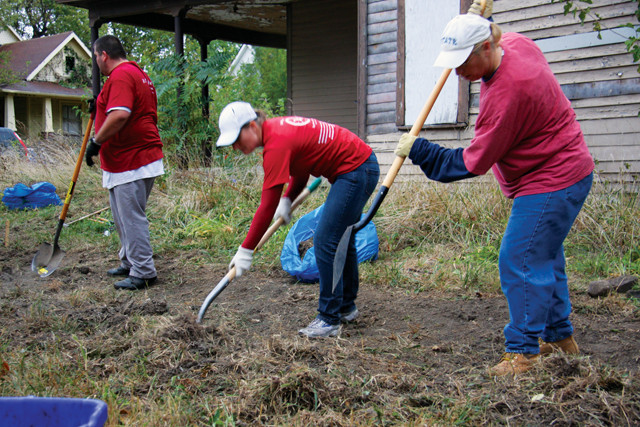
Several gardening practices can be used to remediate soils to lower lead contamination. Credit: Center for Urban Health.
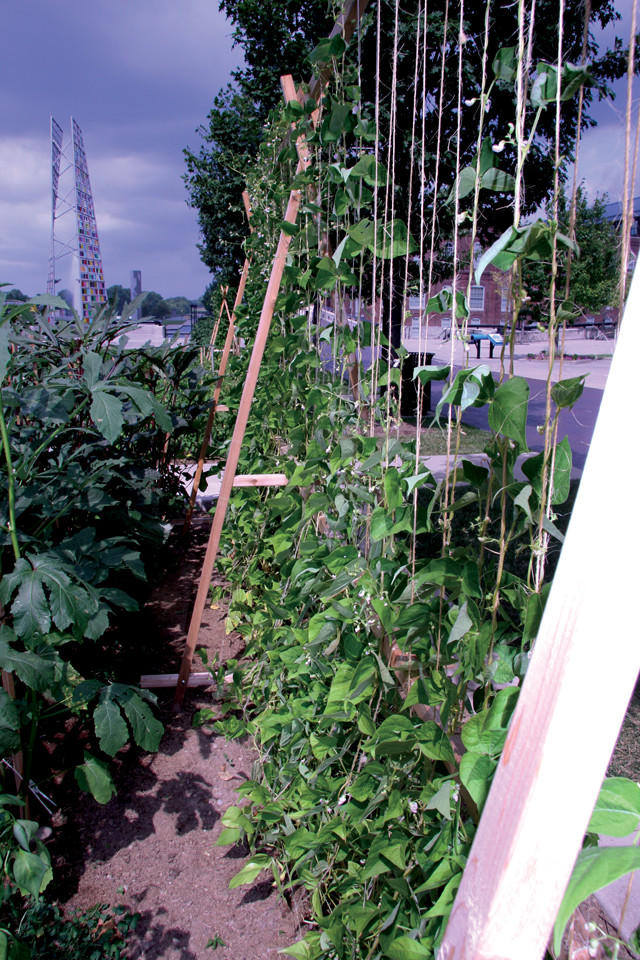
Green beans grow on a string trellis in an urban garden. Credit: Center for Urban Health.
The hazards of lead in urban soil are very real, but a number of good urban gardening practices can help reduce risk.
Adding clean soil from sources outside the city is often the most economical way to transform highly contaminated gardens, Mielke says. “It’s very costly to remove contaminated soil — about $36 per cubic foot — as it’s [considered] hazardous waste that has to be properly disposed of. Adding soil generally costs about $2 to $4 per cubic foot, so that’s very reasonable.”
Mielke has spent decades working to reduce lead levels in parks, playgrounds and gardens in New Orleans. His mission got a boost in 2005 when much of the city’s surface had its lead slate wiped clean by Hurricane Katrina. The lead wasn’t washed away by the hurricane. Rather, the flooding delivered a thin veneer of new sediment a couple of centimeters thick that buried the contaminated soil. In the years since the hurricane, children’s blood lead levels in New Orleans have dropped, on average, by about 33 percent, a rare bright spot in the aftermath of the devastating flood. “There’s not a lot of funding out there for remediation, but it doesn’t take much [new soil] to make a big difference,” Mielke says.
Mielke also recommends building raised beds on top of a layer of geotextile, a porous type of fabric sold at garden shops that creates a barrier that permits the passage of water, but not lead-contaminated soil. In addition, studies have shown that some types of plants, such as mustard and spinach, take up lead internally and can thus be used to clean up the soil, a process known as phytoremediation. One project, led by Samantha Langley-Turnbaugh, now at Northern Kentucky University, lowered the lead count in a test plot by 200 ppm by growing spinach for three months. Crops used for phytoremediation, however, cannot be eaten and should be properly disposed as toxic waste.
Another way to decrease the mobility of lead is by monitoring the pH levels of the soil, and adjusting soil acidity if necessary, McBride says. “The pH of urban soils tends to be rather high [compared to typical soils], about 6.5 to 7.5,” she says. Fortuitously, “that’s also the range where lead is least bioavailable.” But in more acidic (and more alkaline) soils, lead has greater mobility, increasing the odds of it finding its way into plants and animals.
Adding certain minerals and nutrients can also help reduce the risk of lead contamination, Chaney adds. “Phosphate reacts with lead to form an insoluble compound that’s not bioavailable. Adding phosphate reduces the bioavailable lead by as much as 70 percent.” Ingesting lead that is not bioavailable is not necessarily harmless, but it’s significantly less harmful than lead that has not reacted with other elements, Chaney says.
“Urban gardening is fantastically healthy, sustainable and educational, if you manage your garden safely,” Filippelli says. “You don’t have to abandon your soil, even if it is contaminated. There are ways to make it right.”
© 2008-2021. All rights reserved. Any copying, redistribution or retransmission of any of the contents of this service without the expressed written permission of the American Geosciences Institute is expressly prohibited. Click here for all copyright requests.